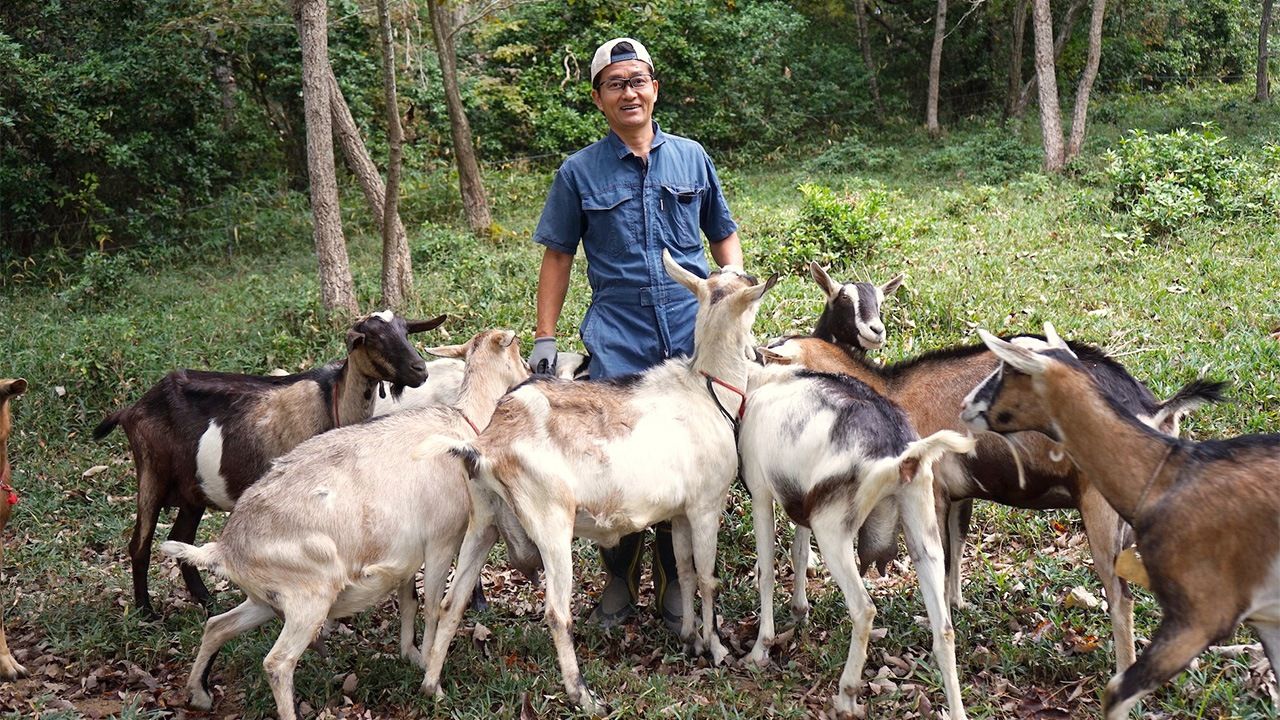
Japanese Agriculture for a New Era
Mirasaka Fromage: World-Class Cheese from Hiroshima’s Hills
Food and Drink Economy Culture Environment- English
- 日本語
- 简体字
- 繁體字
- Français
- Español
- العربية
- Русский
Natural Scenery for Healthier Animals
Dairy farmer and cheesemaker Matsubara Masanori runs Mirasaka Fromage on the outskirts of Miyoshi, Hiroshima Prefecture. When I arrived, he came out to welcome me in front of his cheese workshop and store just after he finished milking.
“Would you like to see the animals on their way back to the mountain?”
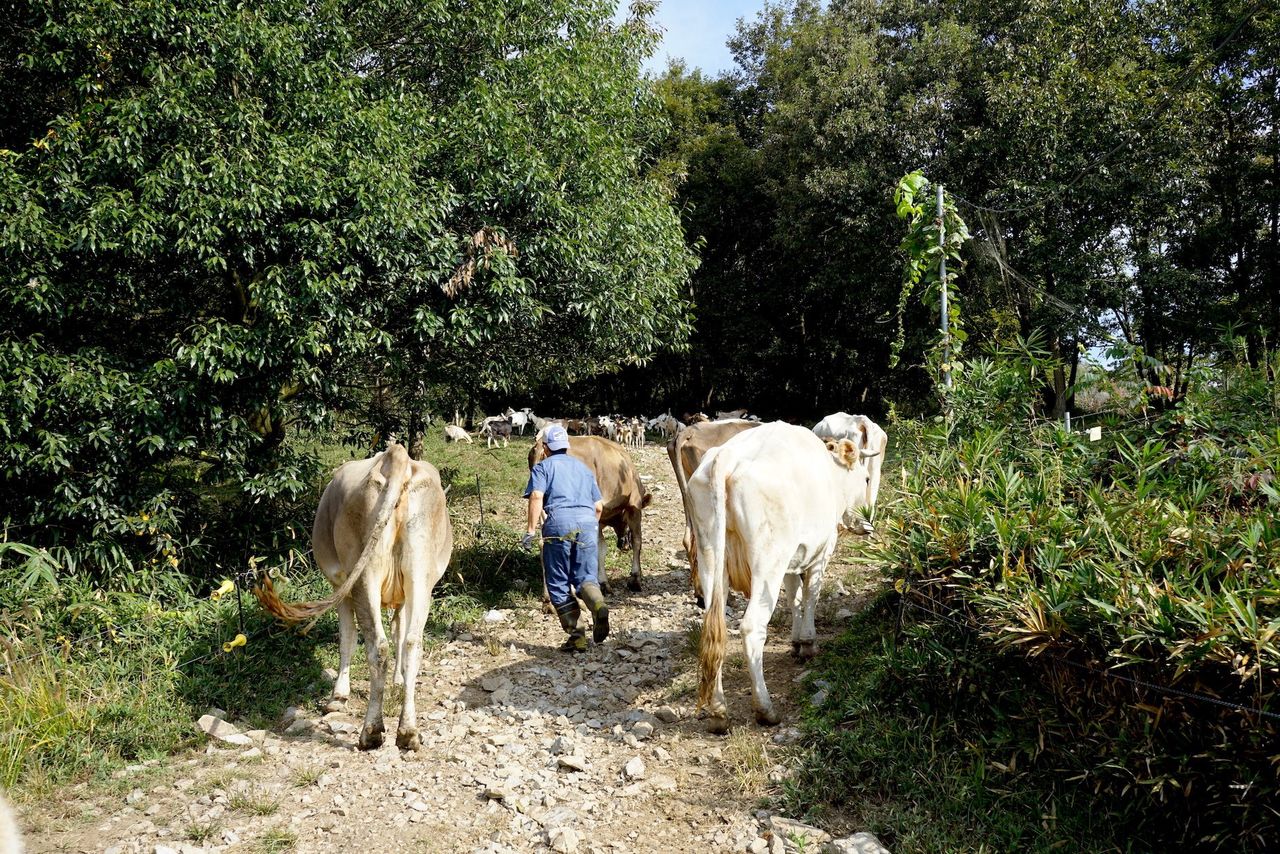
Rather than driving them, he lets the cows head for the hills at their own speed. (© Ukita Yasuyuki)
Taking the track up after the herd, we reach a hillside meadow covered with grasses and bamboo grass and spotted with broadleaf trees. The forest grows in earnest on the other side. The goats, having arrived first, pause in their eating to cock their heads, studying the intruder (that’s me) as they chew. One of them smiles—or so it seems—and comes over as if to greet me. Everything has an air of peaceful leisure.
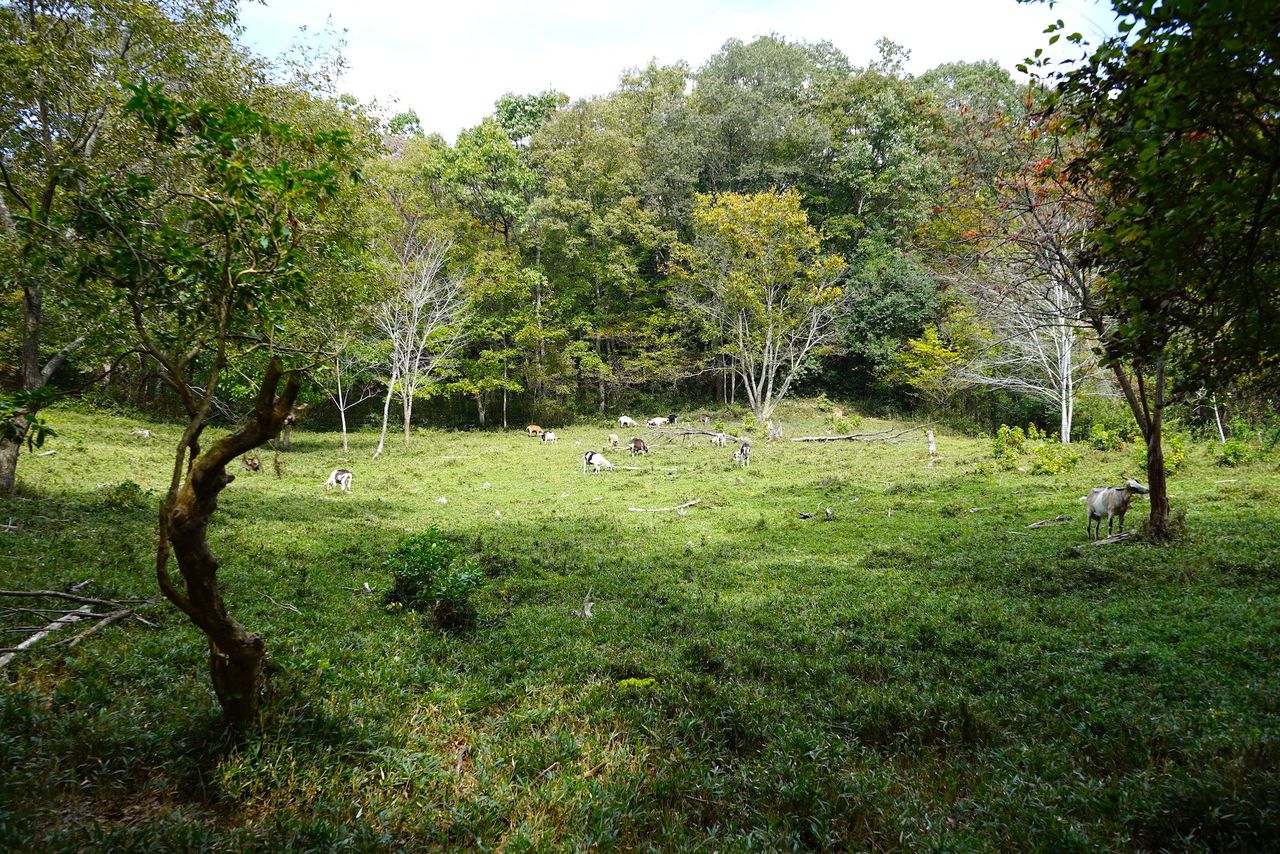
Matsubara cleared the pasture himself. (© Ukita Yasuyuki)
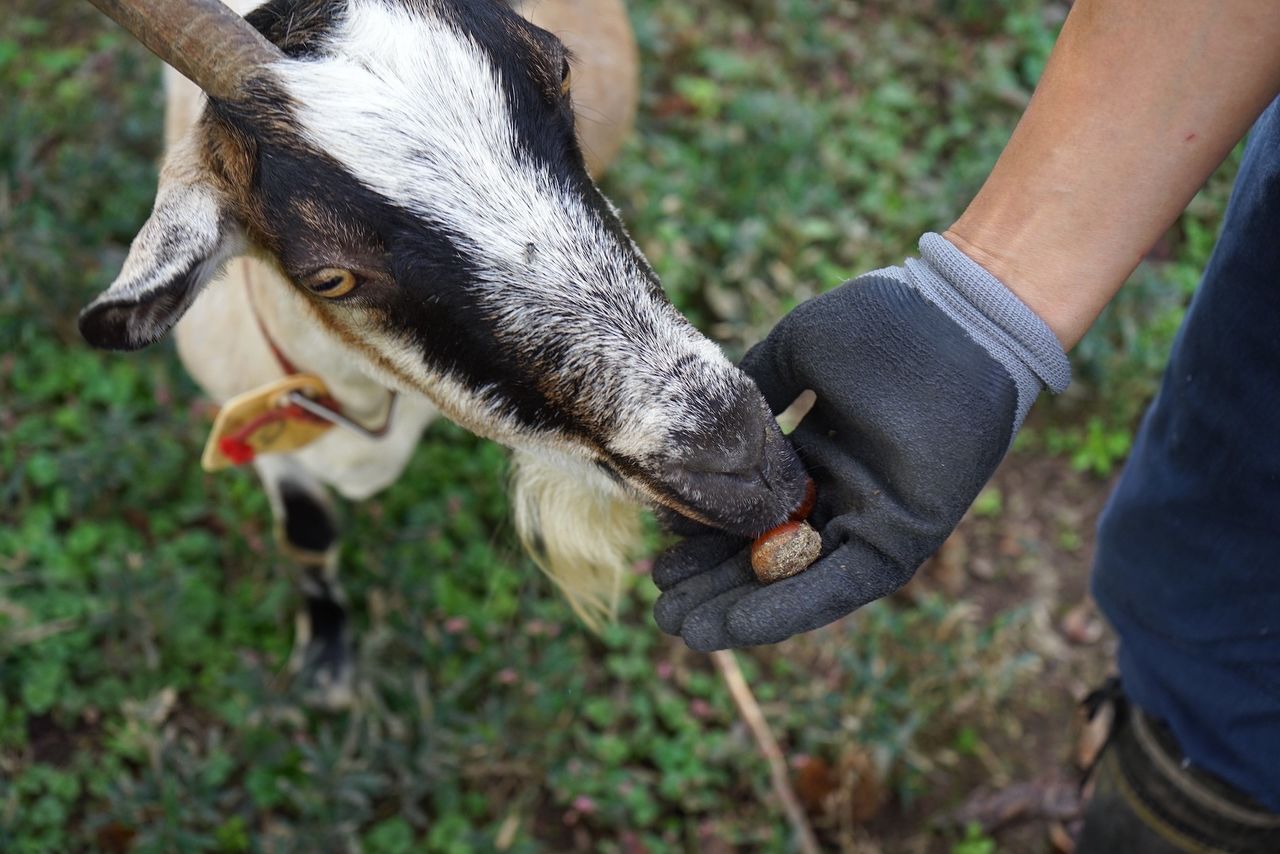
A goat eating chestnuts from Matsubara’s hand. This plot has not only chestnuts but plentiful other growing things like mushrooms, knotweed, and bamboo grass. (© Ukita Yasuyuki)
Matsubara follows a kind of free-range farming unique to Japan, known as yamachi rakunō, or mountainside dairy farming. He has 20 head of cattle and 60 goats that he milks to make cheese and other dairy products for sale.
Yamachi rakunō is a natural farming method proposed in the 1960s by the agricultural scientist Narahara Kyōji. It advocates clearing pastures on hillsides for cows and goats to wander free. It was devised to fit the mountainous landscape of Japan, where it is difficult to secure wide-open, flat pastureland. The approach allows the livestock to live more naturally while also helping to preserve the mountain forest as they eat the grasses and tree buds in moderation and fertilize the soil with their manure. The animals grow healthy and reflect the seasonal mountain forage and changing weather in their quality milk.
“You get more milk if you close them up in a barn and feed them grain, but that puts a lot of pressure on the animals, which in turn puts pressure on the people raising them,” says Matsubara.
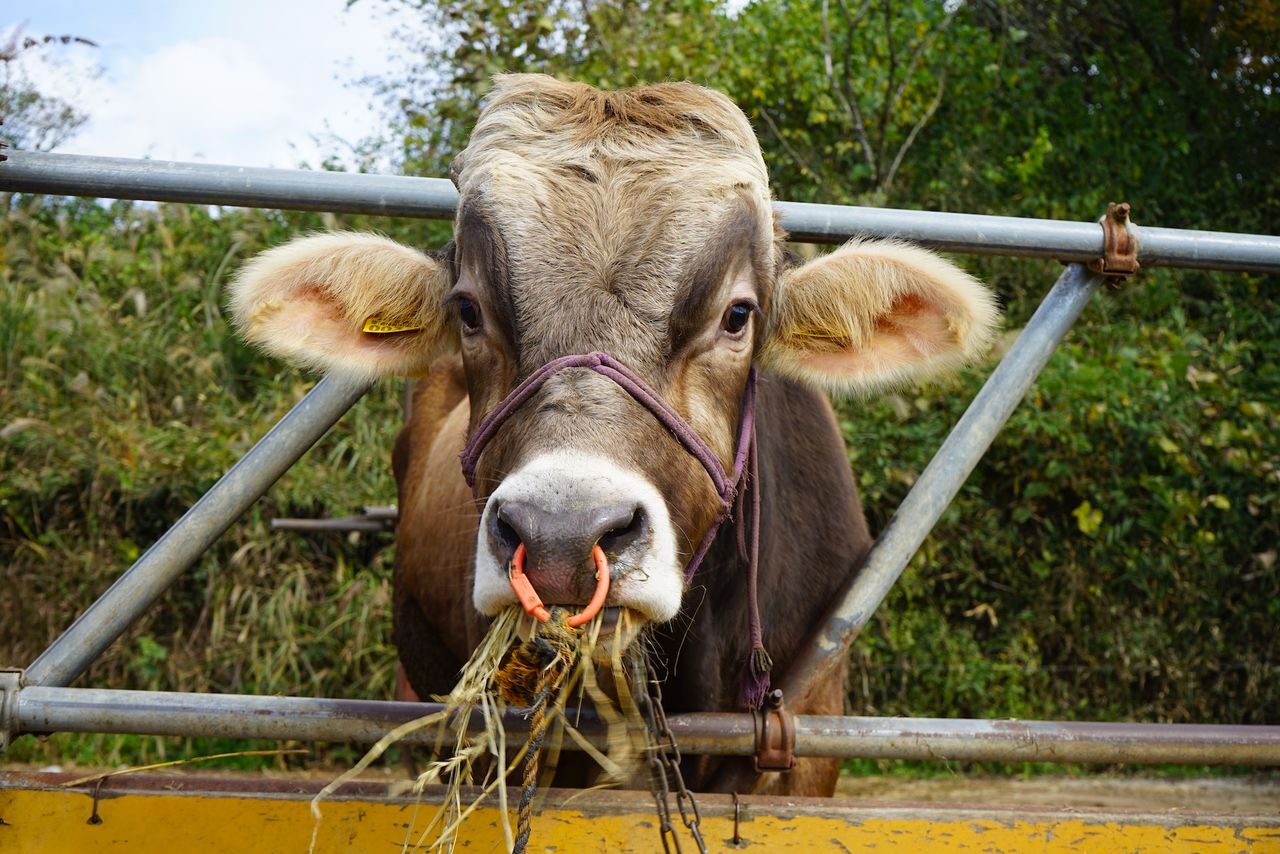
Donut, a candidate for stud bull. All of the animals are named after sweets. (© Ukita Yasuyuki)
Matsubara says he decided to take the animals’ quality of life into consideration in his breeding and dairy farming after an unusual experience he had when training at an overseas farm just after graduating from a prefectural agricultural technology college.
The Anger of the Herd
“It was when I was staying at a farm in Australia. It was a massive farm, where they milked a thousand head of cattle twice a day. They really valued productivity, and it felt like the animals and people both were just like machines. When you have a thousand head, animals die pretty much every day. One time, the farm owner told me to take a tractor and dump a cow’s carcass into a valley. I did what he said and chained the carcass to the tractor, then dragged it out to the corner of the farm. I got to the gate, and one cow stood up and started glaring at me. It mooed a low, angry bray. Then other cows started to gather and started making that same harsh braying sound. I suddenly felt like I understood what the cows were saying to me.”
We endure this terrible life for humans, do our best to make milk, and yet you all don’t give a thought to our happiness, do you?
That’s how he understood those angry cries from cows—animals that usually are so calm, hardly ever showing any hint of emotion. Wait, now, I didn’t kill this cow. If you have any complaints, tell the farm owner. Tell the wholesalers and the customers who demand the milk, he thought. Matsubara cried.
That one incident almost killed Matsubara’s enthusiasm for dairy farming. He had followed the path out of his love of animals and his belief in the potential of dairy farming, but if the reality would be his own participation in such human exploitation of animals, he thought he might have to quit. But as he thought back on that time surrounded by cows, a different idea occurred to him.
“Could it be that the cows were asking something of me, in particular? Is there something I could do? I will get a cow, even just one, and raise it carefully, in my own way.” With that resolve in his heart, he returned to Japan.
The Forestry at the Heart of Agriculture
Matsubara began researching farming methods that were kind to animals and suited to Japan’s landscape, and that is when he learned about yamachi rakunō. He went to learn from Saitō Yōichi of Satō Farms in Kōchi Prefecture on the island of Shikoku. Saitō had been free-range farming since 1968, and the first thing he told Matsubara was, “If you want to try yamachi rakunō, learn forestry.”
So, he went back to his hometown of Miyoshi and apprenticed with a group of foresters who taught him the names and characteristics of trees, how to cut them, and how to use their equipment. It is a hard, dangerous world that sends some people who try running away in their first day—or even the first few hours.
When he finished two years of forestry work, Matsubara then headed to France to learn cheesemaking in the region of Franche-Comté, on the Swiss border.
Even if he succeeded in clearing a hillside, grazing animals, and getting good milk, he realized, he would still need a sales channel. Selling raw milk to the Hiroshima Prefecture Dairy Cooperative would mean low purchasing prices, and and his milk would get mixed with other farms’ to boot, meaning the natural flavor of free-range milk would never get to shine. And free-range animals don’t make much milk in the first place. The only way to be profitable would be through processing it into something with added value, rather than as raw milk. That meant that, along with yogurt and ice cream, cheese was a prime candidate.
In 2004, after he had returned to Japan, he started by opening a cheese workshop and making cheese out of milk bought from the dairy coop. In 2006 he found the 9-hectare plot he now owns, which it took him two years to buy for what he describes as the price of a single luxury car. With backhoe and chainsaw, he cleared the land himself, left trees that would produce chestnuts and acorns for feed, and seeded it with Japanese grasses for grazing. The first herd he pastured on the mountain comprised three calves and six kid goats.
In the meantime, Matsubara’s mozzarella won the grand prize at the 2007 All Japan Natural Cheese Contest, one of Japan’s few cheese competitions. Since then, he has gone on to rank highly at one contest after another. Starting in 2011, the fourth year of his hillside pasture, he was finally able to make his own cheese from his own milk. In 2013, he won a silver medal the Mondial du Fromage, one of France’s most historic cheese contests, with his Fromage du Mirasaka: a matured white mold cow’s milk cheese wrapped in oak leaves. It was proof that Japan’s craft cheese was ready for competition on the global stage.
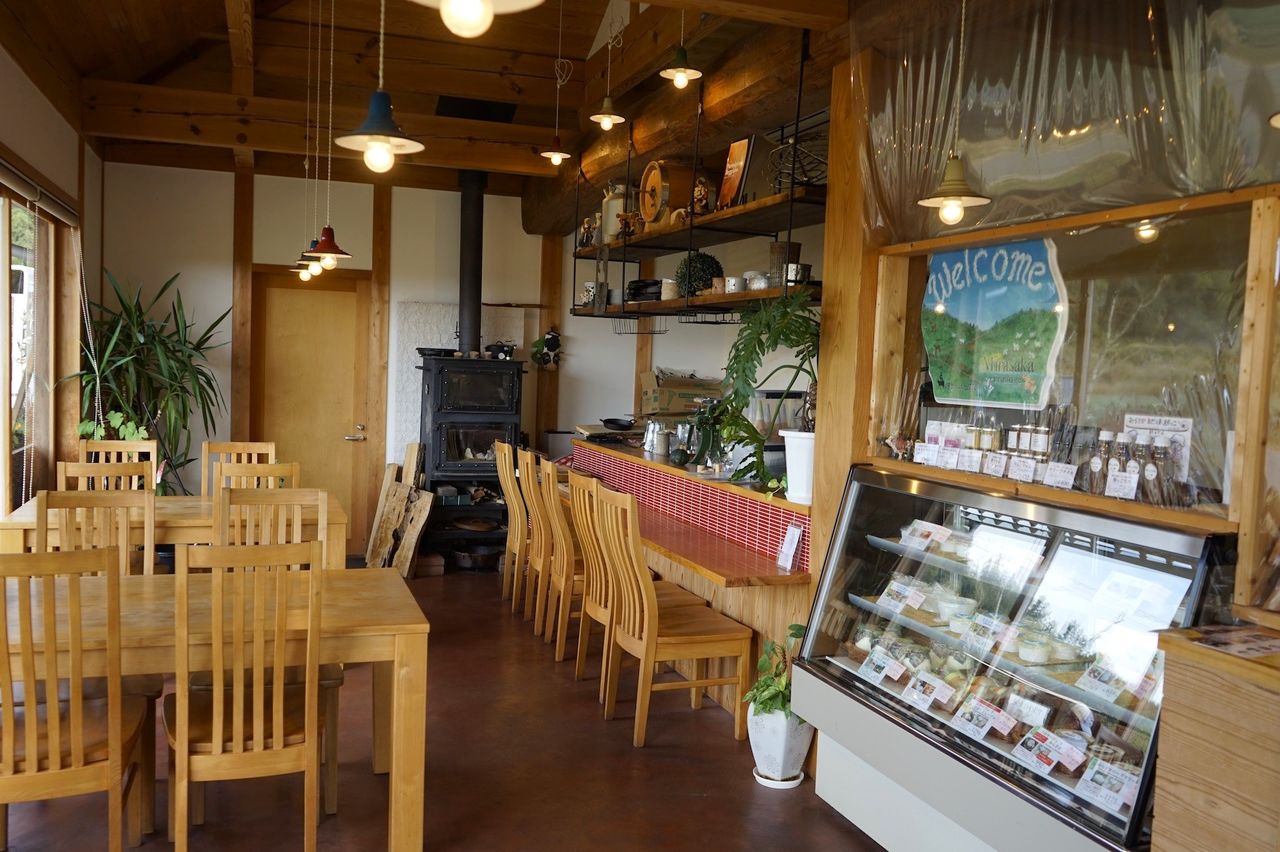
The Mirasaka Fromage café and shop attached to his cheese studio has become a destination for tourists in search of cheese and goat’s milk soft-serve ice cream. (© Ukita Yasuyuki)
What Hiroshima Has Over Hokkaidō
“My mother was someone who made fermented and preserved foods like miso, jam, and umeboshi. I watched and helped when I was a child, and when I make cheese those feelings and memories come back. For example, the work of rolling mozzarella into a ball is just like rolling mochi.”
When he gave cheesemaking a try, it turned out that the work suited Matsubara’s nature. Oddly, the long hours didn’t seem to bother him.
The fresh cheeses like Chevre Frais that are his particular strengths all show subtle changes in flavor with the season. On the mountain, the animals eat tree buds and bamboo shoots in spring, green grass in summer, chestnuts and acorns in fall, and bamboo grass in winter, and he says the milk they produce reflects the aromas of what they eat. That offers attraction and value directly opposed to standardized milk that tastes the same all year round.
Most people in Japan think of Hokkaidō when it comes to Japan’s dairy industry, but for free-range farming, Matsubara believes that areas where enclosures are not needed due to a lack of heavy snow have the advantage. Hokkaidō’s cattle must spend up to a third of the year in barns, but Matsubara’s farm has no barn at all. Until just a short time ago, his region had a long history of being Japan’s cattle-raising leader. Miyoshi is also close to consumption centers like the city of Hiroshima, another advantage that Matsubara leverages by emphasizing fresh cheeses.
Despite the fact that he has continued to amass awards like some kind of medal collector, Matsubara insists, “Awards have little meaning.” He continues to enter contests to demonstrate his products’ quality, increase the awareness of Japanese cheese, and stimulate the domestic industry. But Matsubara’s own interest leans toward, as he says, “Making cheese that reflects the individuality of the animals and tells a story in your mind as soon as you taste it.”
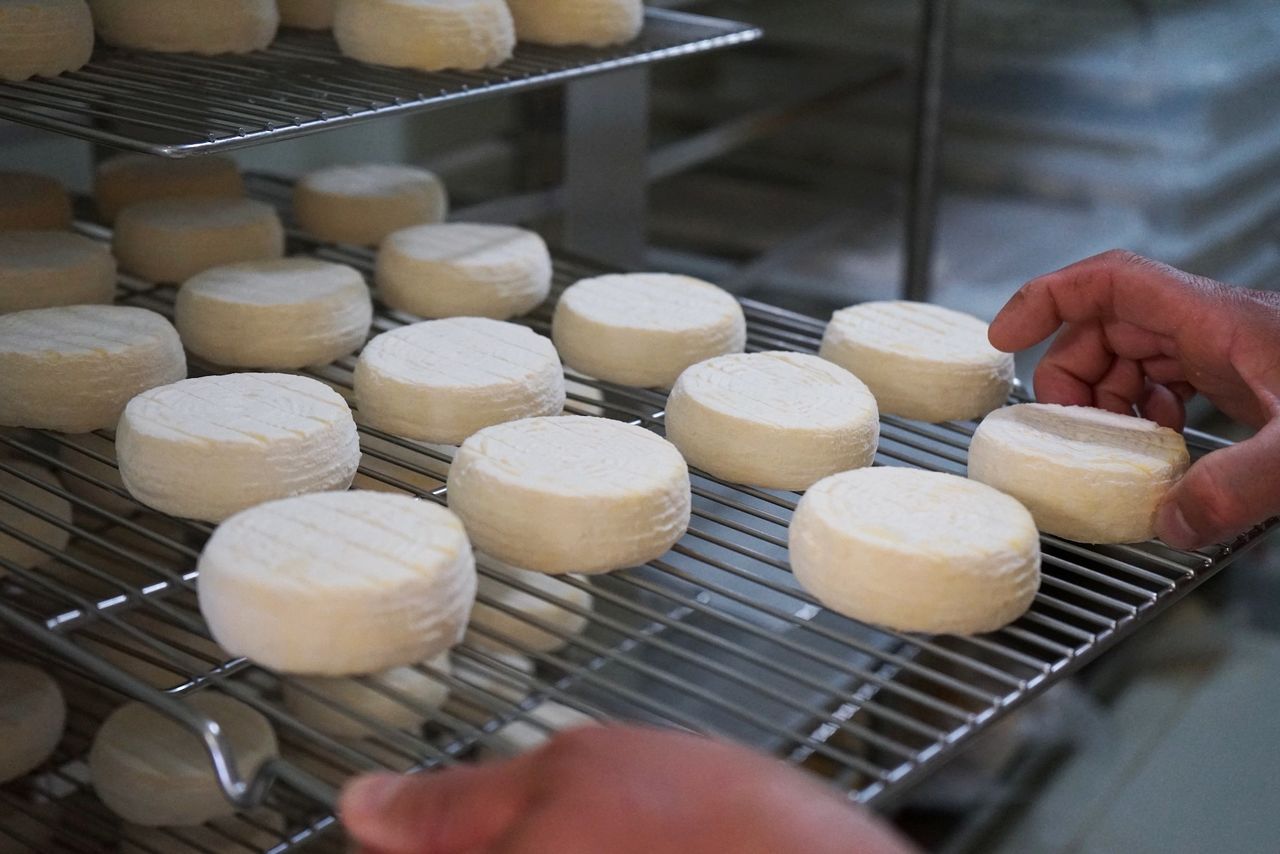
Checking the maturation of Chevre Frais. (© Ukita Yasuyuki)
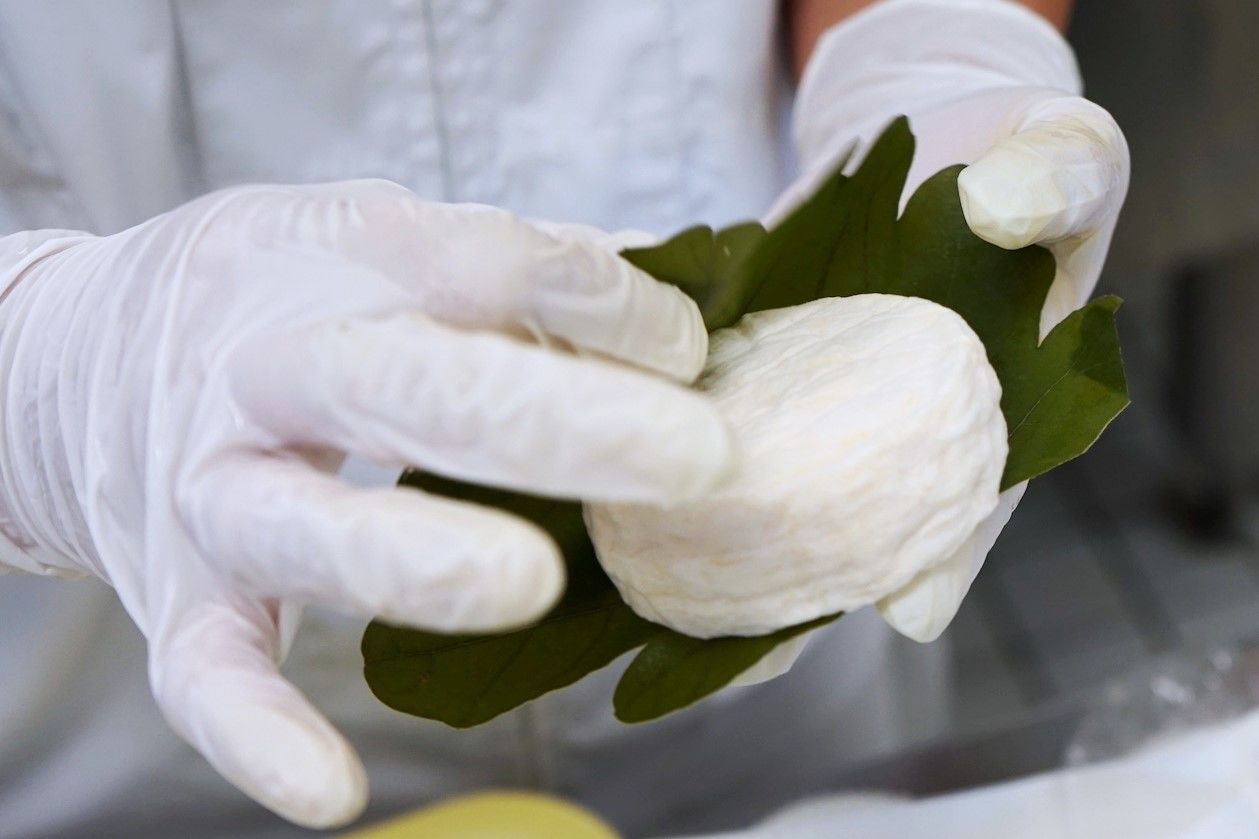
Wrapping Fromage du Mirasaka, one of the dairy’s flagship products, in oak leaves. (© Ukita Yasuyuki)

At left is Fuji Sumi, a cheese shaped like Mount Fuji that reflects Matsubara’s playfulness. It uses goat cheese pressed into a mountain shaped mold, then sprinkled with charcoal for maturing. Right is maturing Akashōbin, a red cheese christened after the Japanese name for the ruddy kingfisher that decorates its sales label. (© Ukita Yasuyuki)
A Recipe a Decade in the Making
With 20 years of cheesemaking and 15 years of free-range farming now behind him, one could assume that growth has been steady for Matsubara. But of course, there have been bumps. The COVID-19 pandemic caused a drastic fall in sales, which brought with it the terrible prospect of having to throw away the milk his livestock had worked so hard to make. He turned to social media in desperation and somehow managed to find buyers for his cheese.
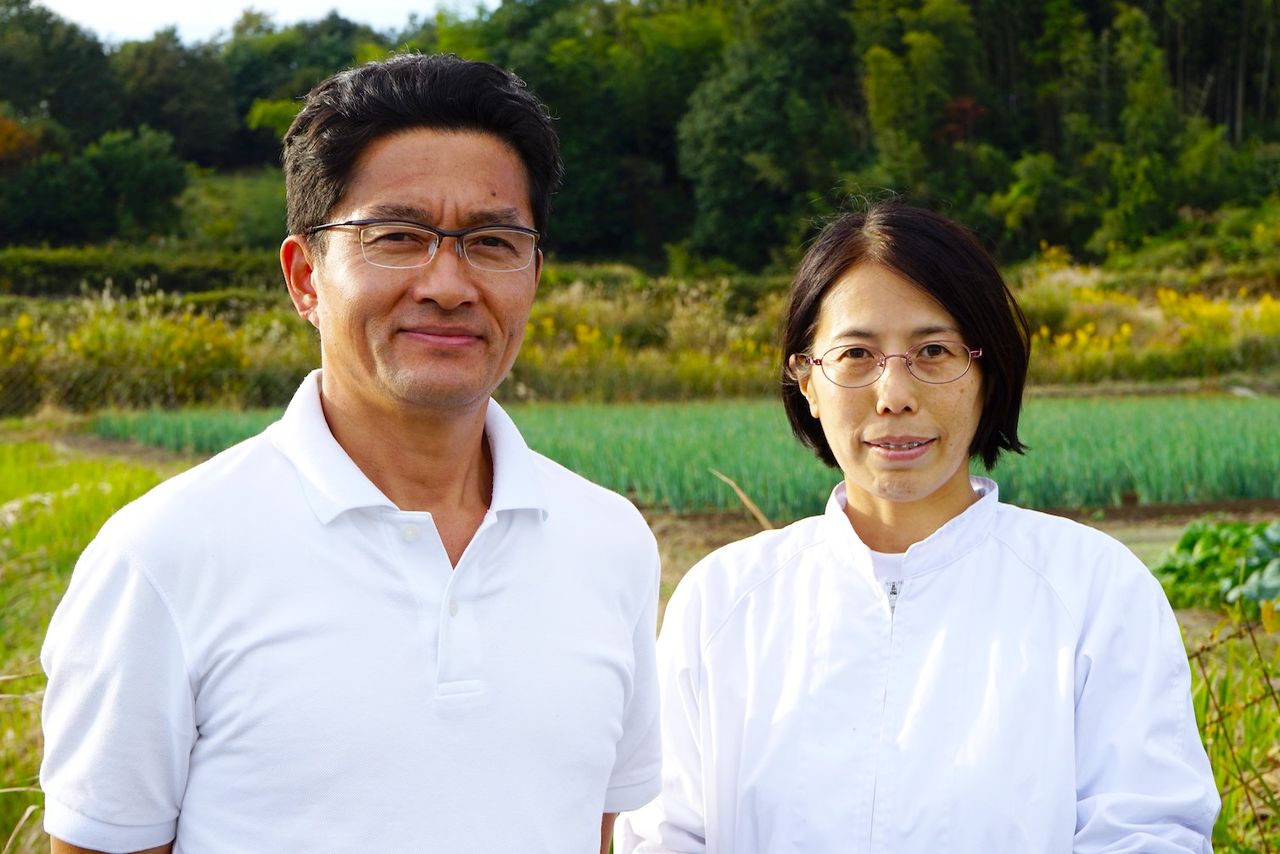
Masanori married Kunie, who now manages the shop, during his forestry days. He says, “We used to tour several farms on our dates.” (© Ukita Yasuyuki)
Matsubara says, “From here, I want to lower the pace and try to live a bit more like Peter,” referring to the young goatherd character in the popular Japanese animated series Heidi, Girl of the Alps. He wants to move from milking by machines to hand and take the temperature management process off the grid. On top of slowing down his manufacturing, when he says, “live a bit more like Peter,” it reflects his desire to live a richer, more fulfilling daily life with both his family and his animals so his children can learn the joys of living alongside other creatures, and his hope to restore confidence to rural communities.
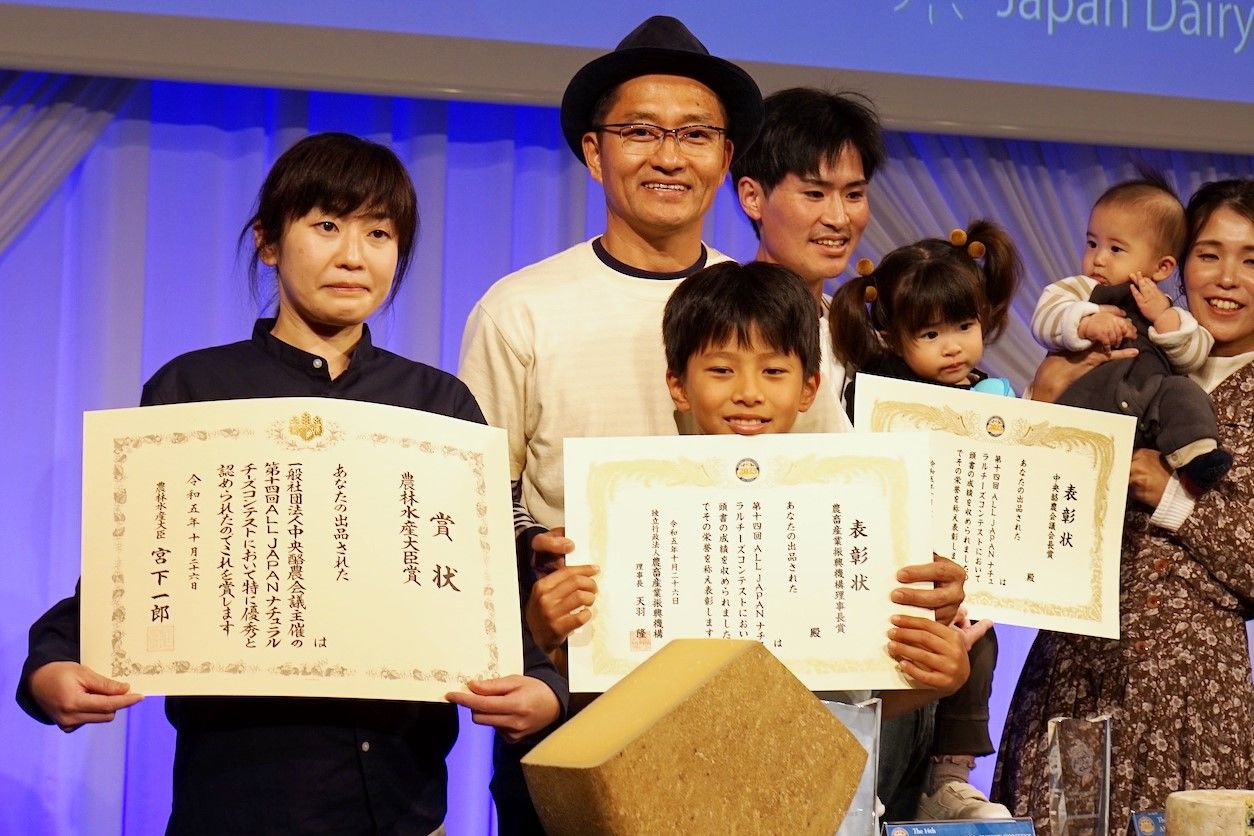
Matsubara with his second son, Luka, at front center, who holds his award certificate from the fourteenth All Japan Natural Cheese Contest, where he won silver. (© Ukita Yasuyuki)
Among the cheeses I got to taste was the Mont d’Or-style Akashōbin. It’s a washed-rind cheese made from free-range Brown Swiss cow’s milk, wrapped in hinoki cypress bark that Matsubara shaved himself. Creamy, rich Mont d’Or is an end-of-year tradition in France, but Matsubara uses spring milk and makes it somewhat light. He says that would make it better suited to Japanese tastes. When he went to France on his cheese training trip and first tried Mont d’Or, he thought, “Someday, I want to make cheese like this, too.” He goes on to explain that it took him 10 years of trial and error to develop a recipe he liked.
This Akashōbin won super gold at the World Cheese Awards in October 2023. It has an aroma that stirs the senses, and the flavor is delicate. The captivating finish lingers subtly in the mouth for what feels like ages, making this a truly outstanding mountain cheese.
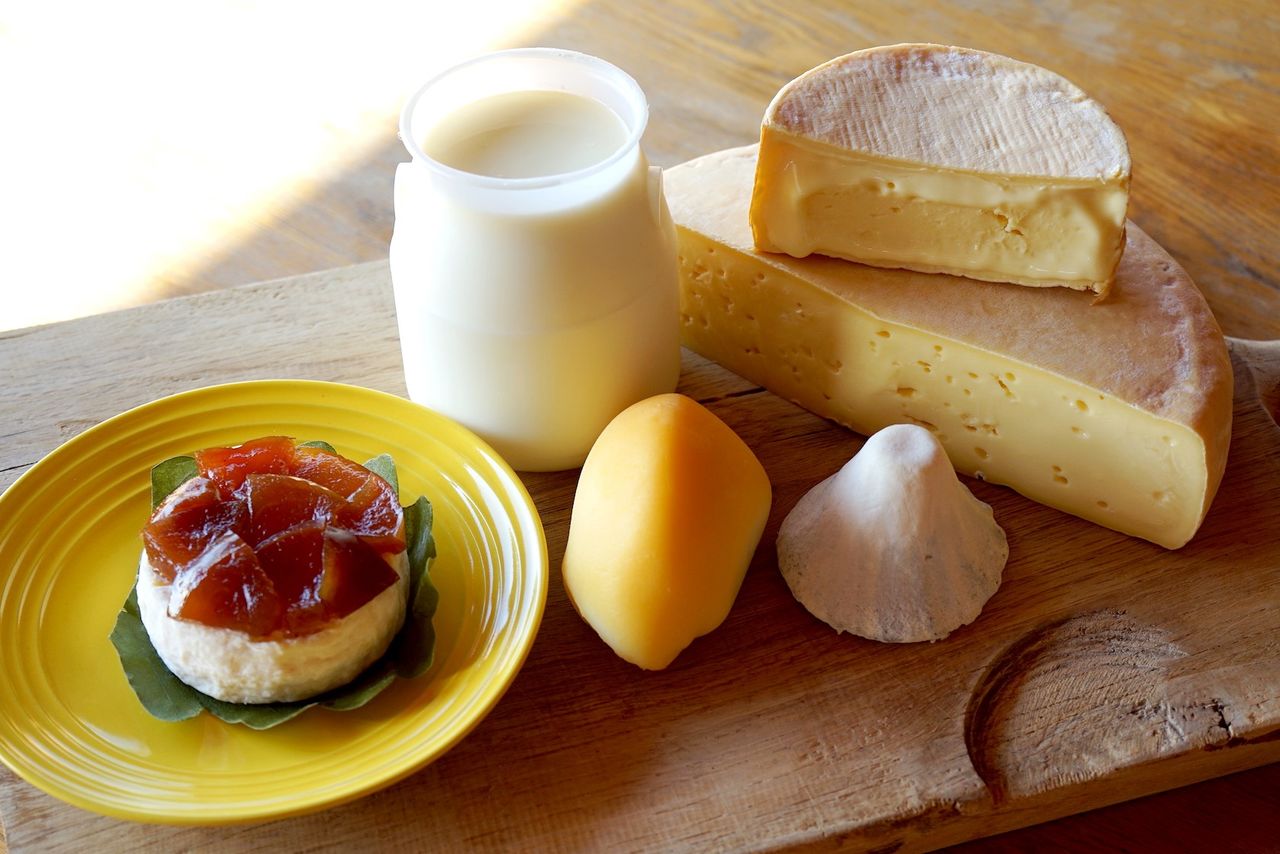
Clockwise from top right: At top is the WCA top prize winner Akashōbin; under that is Reblochon, another washed-rind cheese; goat milk Fujisan Sumi; a hung and smoked Scamorza; Mirasaka Tatin made with local akibae apples; and yogurt. All products are sold at Mirasaka Fromage. (© Ukita Yasuyuki)
(Originally published in Japanese. Banner photo: Cheesemaker Matsubara Norimasa of Mirasaka Fromage dairy. The farm and animals alike are enveloped in a peaceful atmosphere. © Ukita Yasuyuki.)